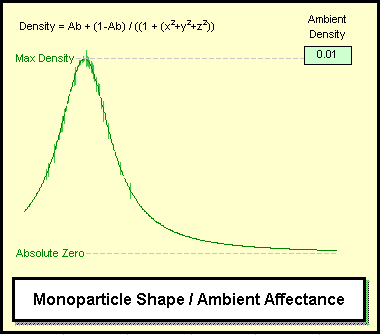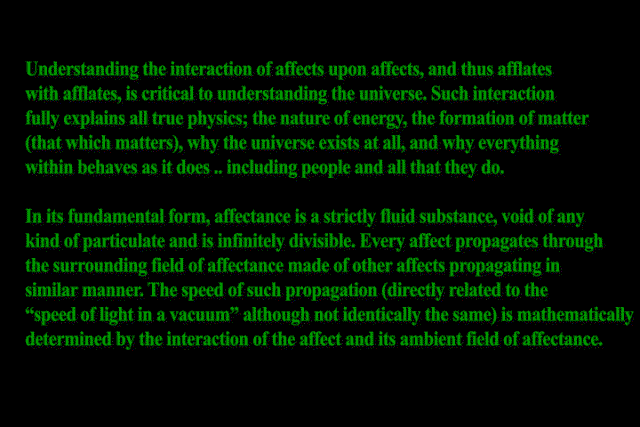The Fundamental Philosophy
[size=85]Written by James S Saint[/size]
[*]Existence
When trying to study existence, the first thing to do is to decide upon exactly what “existence” means. In this case, it is only physical existence that is of immediate interest, so “What is physical existence?”
Since we are creating a fresh understanding of existence, we can define any kind of concepts we choose as long as, in the long run, they prove to be truly aligned with reality and thus useful.
I chose to understand physical existence in the following terms:
[list]That which has physical affect, physically exists.
That which has no physical affect, does not physically exist.
Why would I care about anything enough to claim that it exists if it has no affect on anything?
- pretty simple, but extremely relevant. And that is how the names “Rational Metaphysics” and “Affectance Ontology” were created.
[/:m]
[]Rational Metaphysics is a Method for creating necessarily coherent ontologies. As it turned out, my first effort, Affectance Ontology, covered the entire comprehensive scope of reality, thus I didn’t bother to create any others. I now refer to it as “RM:AO”. Other ontologies could be created and be just as rational if anyone chose to do so.
[/:m]
[]Affectance
In RM:AO, the key substance of physical existence is Affect-upon-Affect = Affectance. In the ontology, physical existence is declared to be made entirely of affectance. From that declaration, further detailed emulation proves whether such a declaration is rational and useful.
Along with the substance affectance, 3D space is also declared (initially merely a “metaspace”). And as it turns out, it is mathematically impossible to have any space without affectance within it. Affectance is infinitely divisible and thus there is no “zero affectance” possible in physical existence (else it wouldn’t be physical as per prior declaration).
To affect is an action, a changing that is taking place. Every change is a changing of the Potential-to-Affect, PtA, of an adjacent point in space. PtA and Affectance can be thought of as voltage (PtA) and current (affectance). The degree, speed, and direction of the changing or affect upon affect causes a propagation of affect, much like a radio wave through the metaspace.
The propagation has a finite speed because it requires more than an infinitely fast change rate in order to cause an infinite propagation rate (each infinitesimal point in space must change to its new value BEFORE the next point in line can begin changing and there are an infinity of such points between any chosen locations thus “infinity/infinity = finite”. There is more detail concerning that in one of my threads). Since no affect can occur at greater than infinite speed, affect propagation is confined to finite speeds (declared to be from 0 to 1 toes/tic).
[/:m]
[]Propagation Effects
As propagating affects cross the same points in space, they combine to demand more and/or faster changing at such points. But in reality, each point is already changing as fast as possible and thus each propagating affect simply has to wait. So affects delay affects, affectance delays affectance. And that is what gives rise to physical inertia, mass, and momentum.
As delays in propagation occur, oncoming affects begin to pile up forming a traffic jam of higher density affecting - more changing taking place within the same amount of space. And just as there is a limit to propagation speed, there is also a limit as to how much changing can occur within a given amount of space. When that maximum occurs, particles form as perpetuating traffic jams of affectance that we refer to as “sub-atomic particles”.
Particles have the property of hardness and inertia simply because so much changing is already constantly occurring within the particle space that no more changing can be easily added. When no changing can be made … that is what we call a “hard object” and is the make of ALL matter and material objects.
[/:m]
[]Positive and Negative Charge
A point can be affected by changing its PtA to be either greater or lesser. The increase in PtA is referred to as “positive change”, a greater potential to affect its surroundings. As an increasing affect propagates, each point traversed temporarily gains more PtA. And as a decreasing affect propagates, each point traversed temporarily loses some PtA. There is no negative amount of PtA. A point either has PtA or doesn’t exist. But there is an average level of PtA in every region. Any wave of affect that increases above that average is a positive wave and any below the average is a negative wave. There is no “below zero PtA”. Thus we inherently have a regional PtA level (how much potential to affect is in the region) as well as a regional affectance density (how much activity/changing is in the region). Anything above the average PtA level for the region is “positively charged”. And anything below the average PtA level is “negatively charged”.
[/:m]
[]Three Fundamental Particle Types
As it turns out, positive affects form positive particles - traffic jam clumps that have above regional average PtA. And negative affects form negative particles with below regional average PtA. These are later discovered to be what science current refers to as “positrons”, “electrons”, and for the particles of even PtA, “neutrinos”.[/*:m][/list:u]





 [/list:u]
[/list:u]



